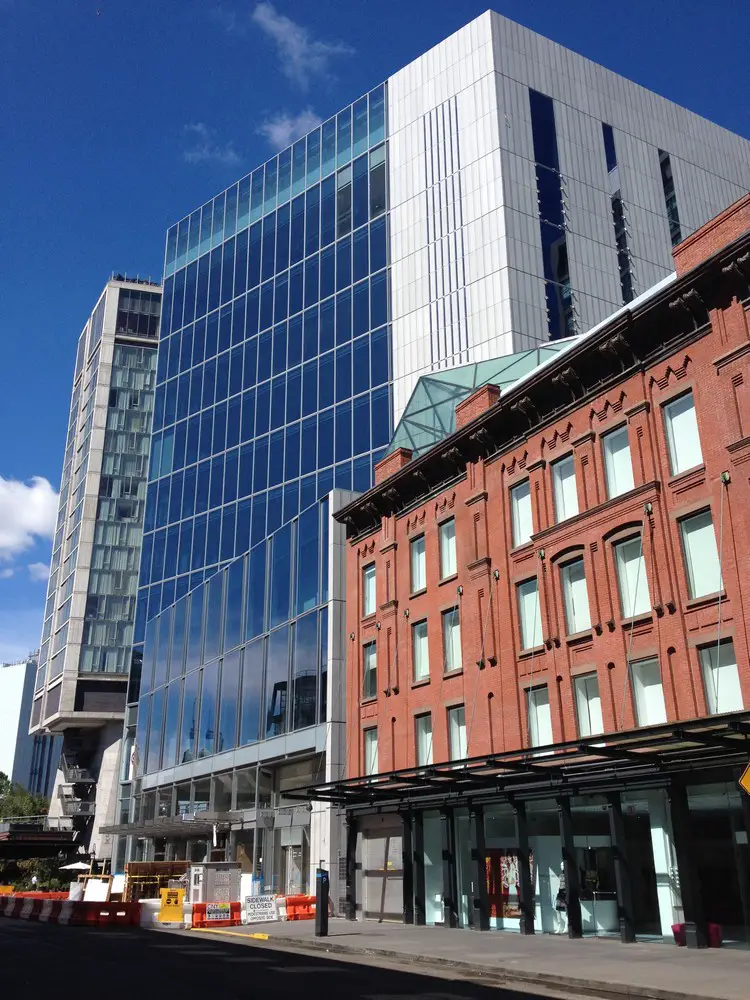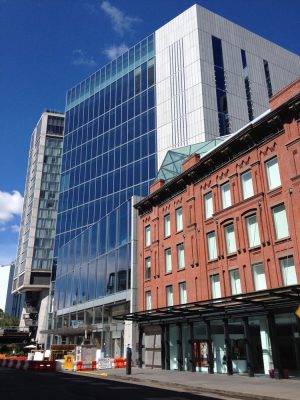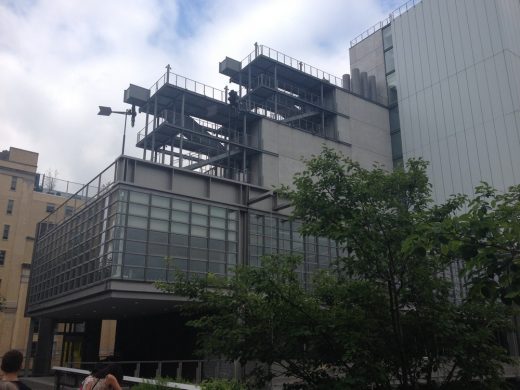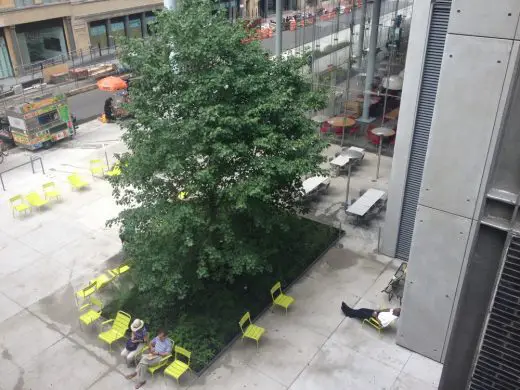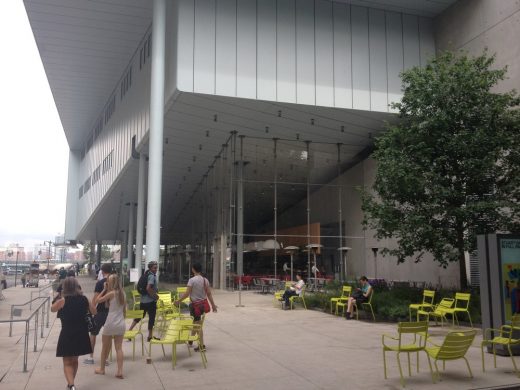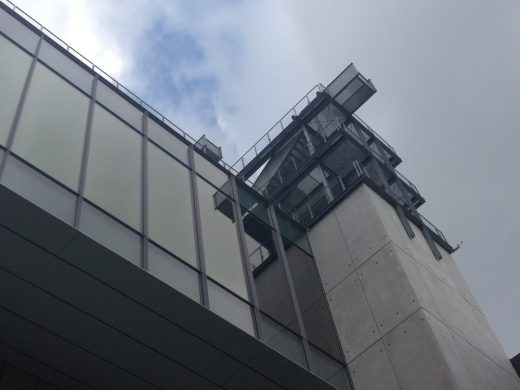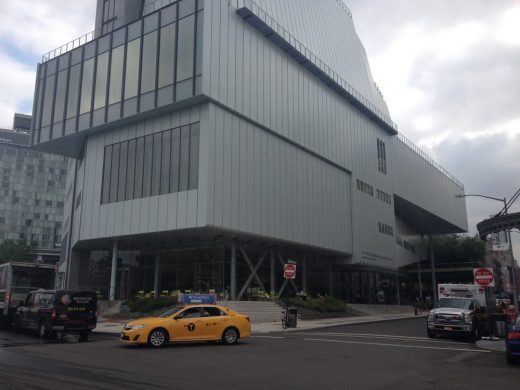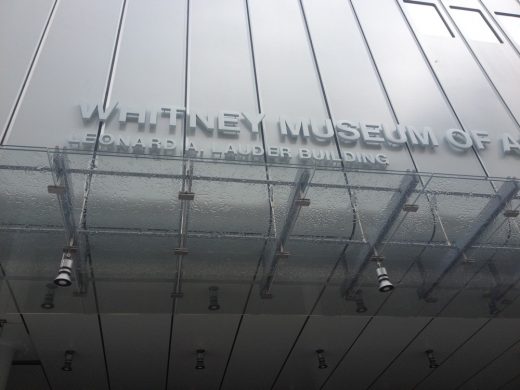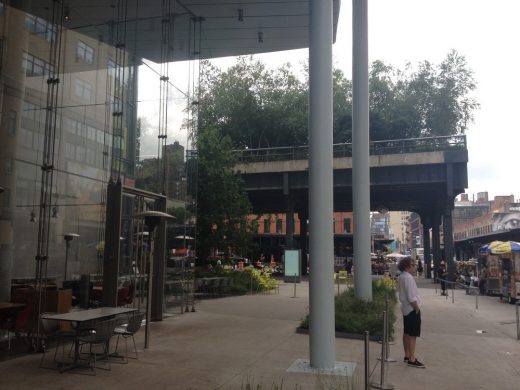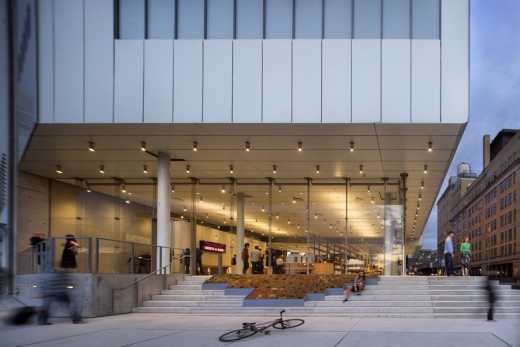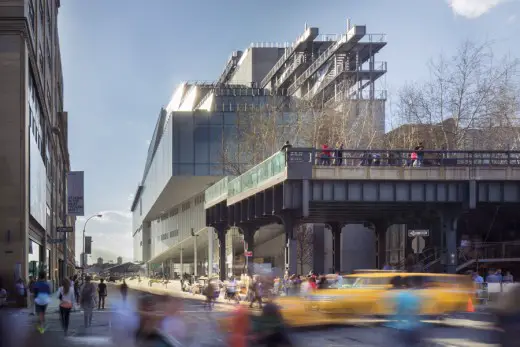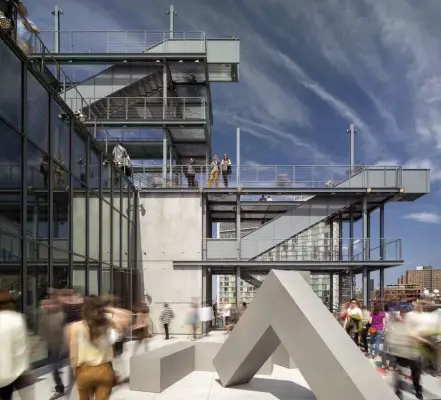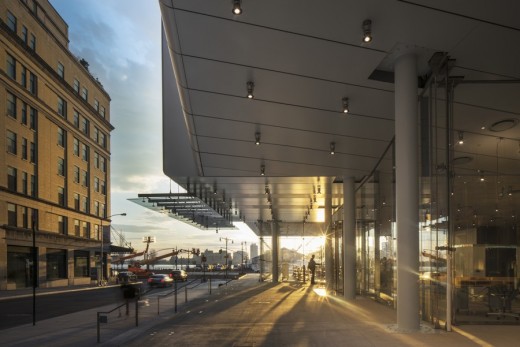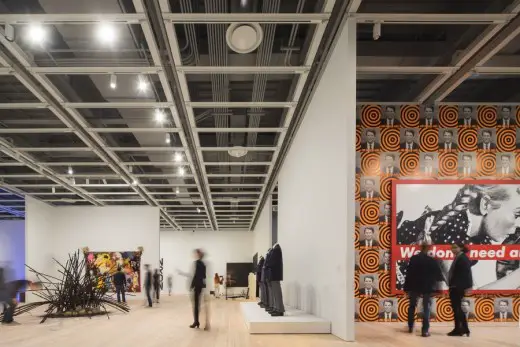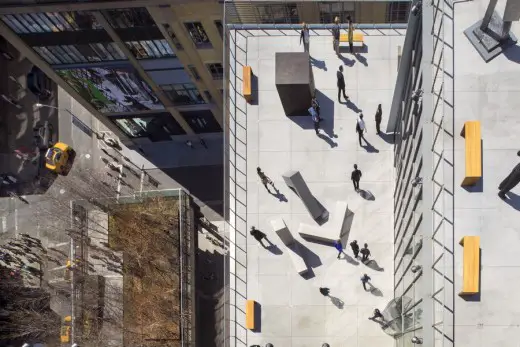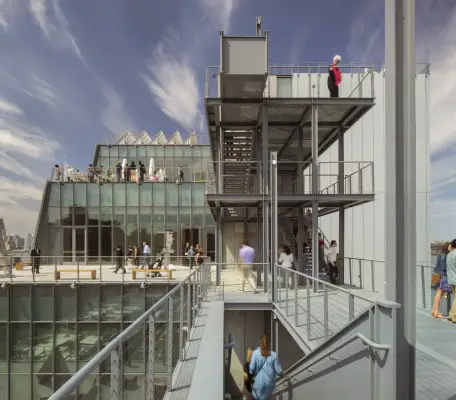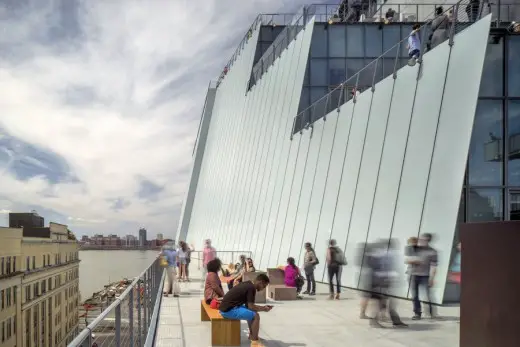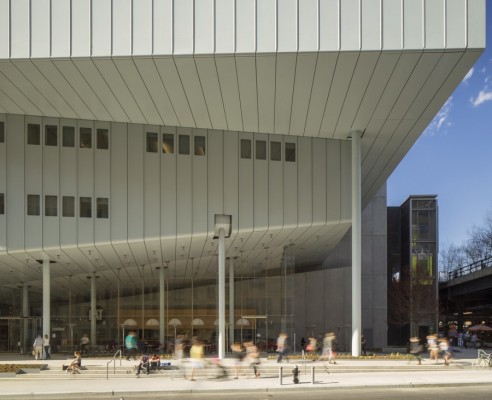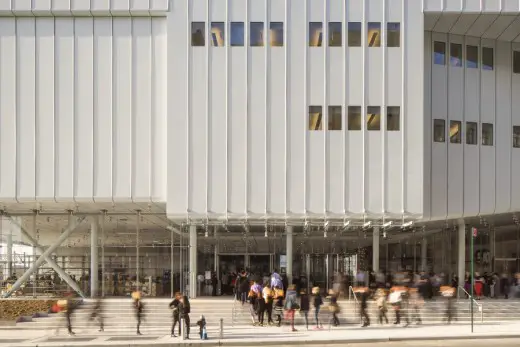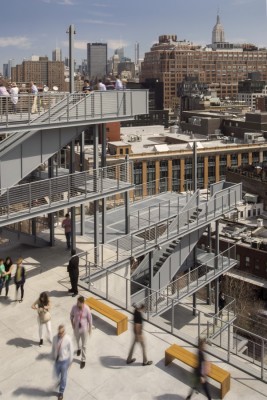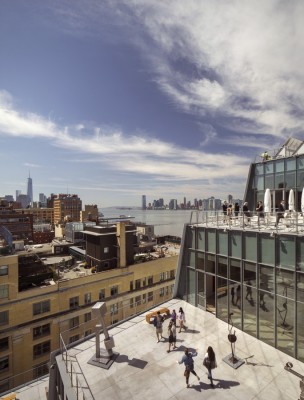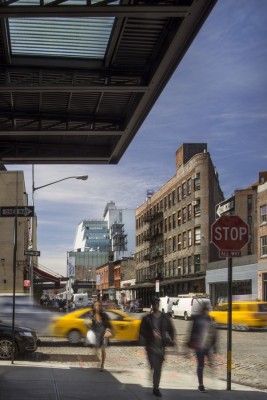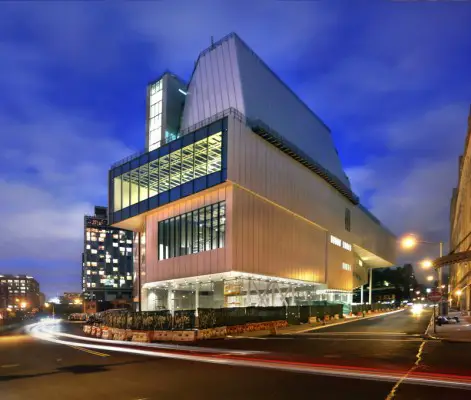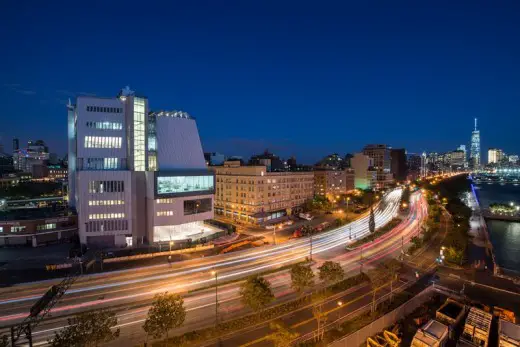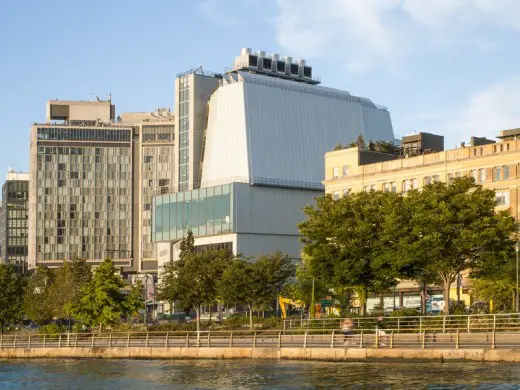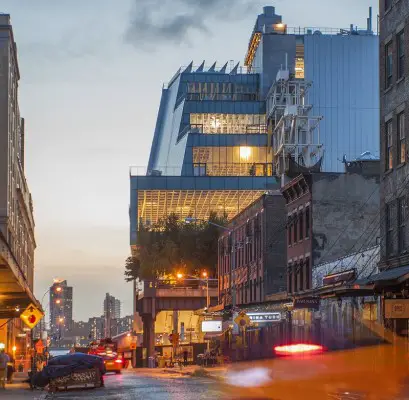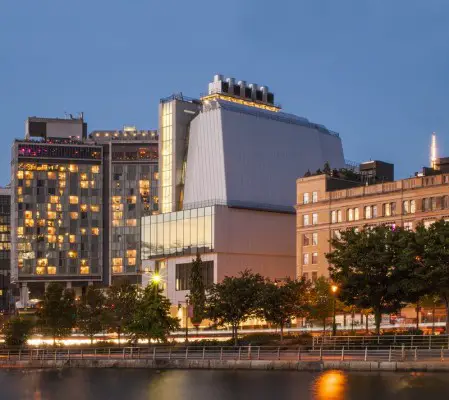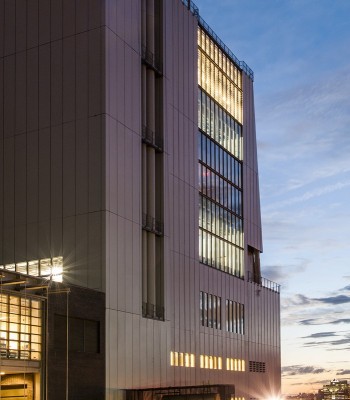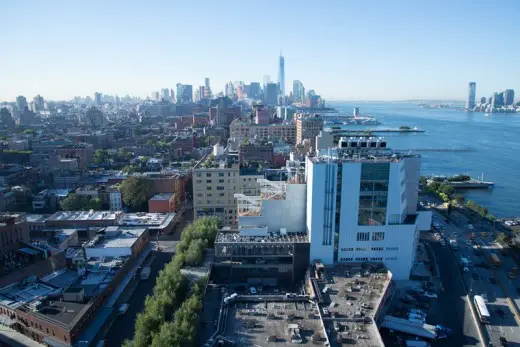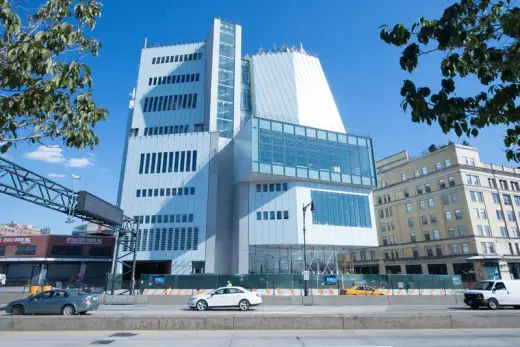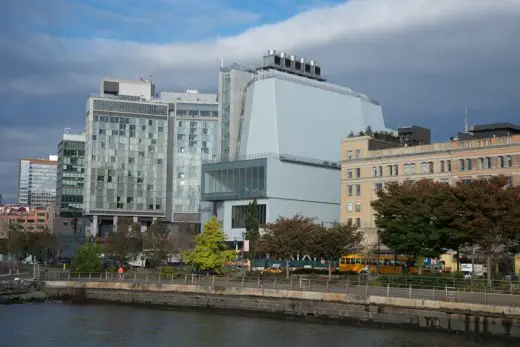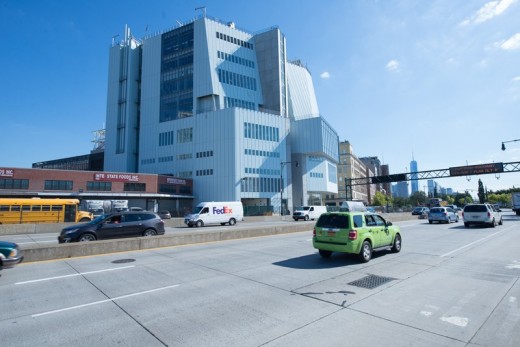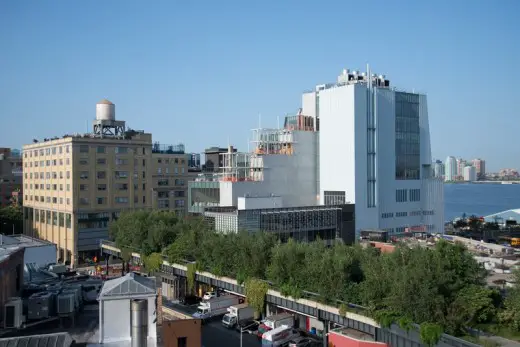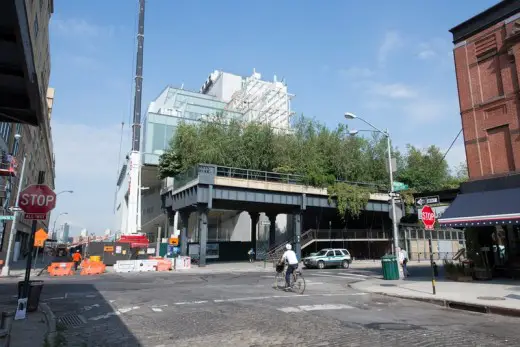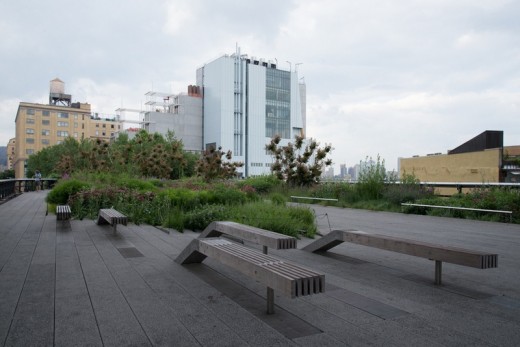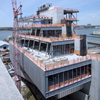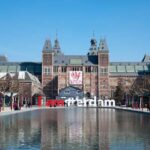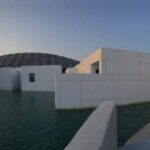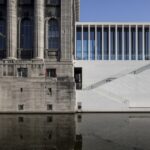Whitney Museum of American Art Building New York, NY Architecture, Architect, US News
Whitney Museum of American Art New Building, NY
Gallery Collection in Manhattan, NYC, USA design by Renzo Piano Building Workshop (RPBW)
Whitney Museum of American Art New Building is an American Architecture Awards Winner in 2017
Apr 7, 2017
Whitney Museum of American Art New Building News
Whitney Museum of American Art New Building shortlisted for American Architecture Awards
One of seventy-nine shortlisted buildings that have won the prestigious 2017 American Architecture Awards ® for the best new buildings designed and constructed by American architects in the U.S. and abroad and by international architects for buildings designed and built in the United States.
Jul 4, 2016
Whitney Museum of American Art New Building
Whitney Museum of American Art New Building in New York City
Design: Renzo Piano Building Workshop, Architects
Building images from 24 Jun – 2 Jul 2016 © Adrian Welch:
May 3 + 1, 2015
New Whitney Museum Building Opening
Michelle Obama inaugurates Whitney Downtown Museum Building, Manhattan, NY
The first lady uses inaugural speech to urge galleries and museums to reach out to young people who do not feel that such cultural institutions are for them, reports The Guardian.
“As she delivered the inaugural address for the Whitney museum’s new building in downtown Manhattan on Thursday, Michelle Obama praised the museum for its outreach work to children and underserved communities, and challenged other cultural institutions to do the same.
In front of a crowd of museum trustees and art world VIPs, New York City mayor Bill De Blasio and architect Renzo Piano joined Obama in officially opening the new Whitney for business. At 200,000 sq ft, the new building is nearly double the size of its former home on the Upper East Side, which was no longer large enough to house both the museum’s staff and its 22,000-strong art collection.
The Whitney Downtown Museum Building weighs 28,000 tons, including 4,000 tons of steel – Renzo Piano said it was his mission to create a feeling of community and freedom in the museum’s design. “I think public buildings are the essence of cities,” he said. “They are places where people share values. Where they meet and speak to each other. Where they join the city.”
The architect concluded: “Especially among public buildings I love to make buildings for art and beauty. The reason is very simple – because art and beauty make people better people … I’m pretty sure that beauty will save the world. It will save one person at a time. It will do it.”
Renzo Piano’s building was nine years in the making. The museum opens to the public on Friday.”
Apr 23, 2015 ; Mar 9 + 6, 2015
New Whitney Museum Building
Whitney Downtown Museum Building, Manhattan, NY
e-architect US represenatives attended the press briefing today ahead of the May 1st opening, here are a new building photos © Nic Lehoux:
New Building for the Whitney Museum of American Art, designed by architect Renzo Piano, to Open in Downtown Manhattan on May 1, 2015
New photos added of this major new American building by the famous Italian architect studio
Construction Nears Completion; Building Will Showcase the Whitney’s Unsurpassed Collection as Never Before, Provide Unprecedented Space for the Museum’s Exhibitions and Programs, and Contribute to the Energy of a Vibrant Downtown Neighborhood
View from West Side highway, September 2014. Photograph by Ed Lederman:
NEW YORK, NY—One of the most significant cultural projects in New York City in this decade, the Whitney Museum of American’s Art’s new 220,000-square-foot building, located at 99 Gansevoort Street between Washington Street and the Hudson River in downtown Manhattan’s Meatpacking District, is nearing completion and scheduled to open on Friday, May 1, 2015.
View from West side, August 2014. Photographed by Tim Schenck.
Designed by Pritzker Prize–winning architect Renzo Piano and conceived as a laboratory for artists, the building affirms the Whitney’s role as the leading museum of modern and contemporary art of the United States. The new building will approximately double the Whitney’s exhibition space and provide extraordinary possibilities for artists, curators, and audiences.
It will enable the Whitney to expand its pioneering temporary exhibitions—including the Museum’s signature Whitney Biennial—and to present all of its exhibitions in the context of the Museum’s most expansive installation of its unsurpassed collection of 20th- and 21st-century American art. The building includes an education center with dedicated space for state-of-the-art classrooms; a 170-seat multi-use theater; a black box theater for film, video, and performance with an adjacent outdoor gallery; and a Works on Paper Study Center, Conservation Lab, and Library Reading Room. The classrooms, theater, and study center are all firsts for the Whitney.
View from the Hudson River. Photographed by Karin Jobst, 2014:
“We are creating an environment in which visitors will be encouraged to connect deeply with art through an irreplaceable first-hand experience,” stated Adam D. Weinberg, the Whitney’s Alice Pratt Brown Director. “This building will be a place of focused engagement, a site for discovery and risk-taking. Here the most important, challenging, and courageous artists of our time will have a constant presence. I am thrilled to announce that we are so close to realizing this long-held dream for the Whitney.”
View from Gansevoort Street. Photograph by Karin Jobst, 2014:
“Our expansive new permanent collection galleries will be a game changer for the Whitney. They will afford a level of space unprecedented in our history to display both iconic works and present provocative new narratives of art in the United States,” stated Donna De Salvo, Chief Curator and Deputy Director for Programs.
“The terraces adjacent to these galleries offer astonishing views over the rooftops of New York and will function as urban stages. Our new building will also be a perfect home for our dynamic program of temporary exhibitions, screenings, and performances that will continue to embrace the art of the present, but now against the backdrop of more than one hundred years of history.”
View from the Hudson River at dusk. Photographed by Karin Jobst 2014:
With striking views of the Hudson River and situated at the southern entrance to the popular elevated High Line park in one of New York’s most vibrant neighborhoods, the new building is designed to engage a lively and diverse international, national, and local audience. The Whitney broke ground on the project on May 24, 2011. The “topping off” of structural steel occurred in December 2012, and as of autumn 2014 the building is nearing completion and has already taken its place as a visible landmark in the skyline of downtown Manhattan.
View facing the Hudson River. Photographed by Karin Jobst, 2014:
Building Highlights
Renzo Piano’s design takes a strong and strikingly asymmetrical form—one that responds to the industrial character of the neighboring loft buildings and overhead railway while asserting a contemporary, sculptural presence. The 220,000-square-foot, nine-story building includes more than 50,000 square feet of indoor gallery space, with two floors devoted entirely to the permanent collection. (The galleries in the Whitney’s Madison Avenue building, designed by Marcel Breuer, totaled 32,000 square feet. The collection has grown from about 2,000 works at the time of the building’s opening, in 1966, to more than 21,000 works today.)
View from the Standard Hotel looking south, September 2014. Photograph by Tim Schenck:
“The design of this building emerged from many years of conversations with the Whitney, which took us back to the Museum’s origins,” Renzo Piano commented. “We spoke about the roots of the Whitney in downtown New York, and about this opportunity to enjoy the open space by the Hudson River. Museum experience is about art, and it is also about being connected to this downtown community and to this absolutely extraordinary physical setting.”
The new building situates the Whitney within a bustling community of artists, gallerists, students, educators, entrepreneurs, and residents in the Meatpacking District, Chelsea, and Greenwich Village, where the Museum was founded by Gertrude Vanderbilt Whitney in 1930. A dramatically cantilevered entrance along Gansevoort Street at the corner of Washington Street will shelter an 8,500-square-foot public plaza for art (the “Largo”) that is destined to become a popular gathering space, steps away from the southern entrance to the High Line. The lobby, which includes a gallery for permanent collection and special exhibitions and a spacious area for installations, continues the notion of community space and will be open to the public free-of-charge.
View from the Westside, September 2014. Photograph by Tim Schenck:
The expansive fifth-floor temporary exhibitions gallery, approximately 18,000 square feet, will be the largest column-free museum gallery in New York City, and is designed to give artists and curators extraordinary freedom. Approximately 13,000 square feet of outdoor galleries situated on three levels of the building’s rooftops (floors 5, 6, and 7) will offer dynamic exterior exhibition spaces and programmable stages that extend the gallery experience outside.
The building also will feature Untitled restaurant on the ground floor and a café for Museum visitors on the sky-lit eighth floor, both operated by Danny Meyer’s Union Square Hospitality Group and run by executive chef Michael Anthony, and a ground-floor retail shop/bookstore.
Renzo Piano Building Workshop is designing the building in collaboration with Cooper, Robertson & Partners. The Museum is seeking LEED (Leadership in Energy & Environmental Design) Gold certification for the new building from the US Green Building Council. If achieved, it will be New York City’s first LEED Gold-certified art museum. The Whitney has enlisted Piet Oudolf, the influential Dutch horticulturalist, who was part of the team responsible for the High Line, to collaborate with Piano and Mathews Nielsen on the overall landscape design of the building. The plan will incorporate the untamed quality of the High Line to create a harmonious balance of visual elements not only within the Museum, but with its surrounding area.
View from the Hudson River, October 2014. Photograph by Tim Schenck:
Artschwager Commission for Elevators
One of the most striking features of the Whitney’s new home will be its four distinctive elevators. Bringing visitors into contact with art as soon as they enter, the four elevator interiors comprise an artwork by the late Richard Artschwager (1923–2013)—the only commissioned work of art in the building. Six in Four, the title Artschwager gave to the project, is the last major artwork he created before his death in February 2013.
Employing materials such as plastic laminate, glass, and etched stainless steel, the elevators are the culmination of a body of work based on six subjects that occupied Artschwager’s imagination since the mid-1970s: door, window, table, basket, mirror, and rug. Each elevator is designed as an immersive installation featuring one or more of these themes; visitors entering an elevator will have the extraordinary and perhaps somewhat surprising experience of standing under a table; being on a rug in front of a mirror; finding oneself opposite an unexpected door and next to a window; or contained in a giant floating woven basket. Throughout the day the four elevators will be used by the Museum’s visitors; the largest, nearly fifteen feet wide, will also be used to transport art.
View from the West Side highway, September 2014. Photograph by Tim Schenck.
About the Neighborhood
The Whitney’s new building will be the cultural anchor of a revitalized downtown neighborhood, the Meatpacking District, a twenty-square-block area on the far West Side of Manhattan. Surrounding the meatpacking plants just north of Gansevoort Street are numerous architecture and design firms, fashion designers, and high-tech firms as well as some of New York’s most notable restaurants, bars, boutiques, clubs, and hotels.
The neighborhood is bordered by Chelsea, renowned for its art galleries, cultural organizations, and educational institutions. To the south is the West Village and its nineteenth-century townhouses, charming streets, and unique shops. To the west is the Hudson River. The new building is only a few steps from the High Line, New York City’s newest and most exceptional public park. Located thirty feet above street level on a 1930s freight railway, the High Line runs from Gansevoort Street in the Meatpacking District to 34th Street in Clinton/Hell’s Kitchen.
It features an integrated landscape combining meandering concrete pathways with naturalistic plantings. Section One, from Gansevoort Street to 20th Street, opened in June 2009, and Section Two, from West 20th to West 30th Street, in June 2011; Section Three, running from 30th to 34th Street, opened in fall 2014, making the park more than a mile long.
View from the Northeast, August 2014. Photograph by Timothy Schenck.
Campaign for the New Whitney
To date, the fundraising campaign for the Whitney’s new building has generated immense momentum and support. Already $743 million, which represents 98% of the $760 million project goal, has been raised. This total includes $422 million in design and construction costs, $225 million to bolster the Museum’s endowment, and $113 million in capacity-building funds to ensure dynamic artistic and educational programming and for related transition expenses.
Whitney/Met Collaboration
The Whitney and New York’s Metropolitan Museum of Art have confirmed a collaborative agreement under which the Met will present public exhibitions in the Whitney’s Marcel Breuer-designed building on Madison Avenue for a period of eight years after the Whitney’s new building opens in 2015.
View from Gansevoort Street, August 2014. Photograph by Tim Schenck.
About Renzo Piano | Renzo Piano Building Workshop
Renzo Piano was born in Genoa in 1937 into a family of builders. He developed strong attachments with this historic city and port and with his father’s profession. While studying at Politecnico of Milan University, he worked in the office of Franco Albini. After graduating in 1964, he started experimenting with light, mobile temporary structures. Between 1965 and 1970, he went on a number of trips to discover Great Britain and the United States.
In 1971, he set up the Piano & Rogers office in London together with Richard Rogers, with whom he won the competition for the Centre Pompidou. He subsequently moved to Paris. From the early 1970s to the 1990s, he worked with the engineer Peter Rice, sharing the Atelier Piano & Rice from 1977 to 1981. In 1981, the Renzo Piano Building Workshop was established, with 150 staff and offices in Paris, Genoa, and New York.
RPBW has designed buildings all around the world: the Menil Collection in Houston, the terminal for Kansai International Airport in Osaka, the Fondation Beyeler Museum in Basel, the Jean-Marie Tjibaou Cultural Centre in New Caledonia, Potsdamer Platz in Berlin, the Nasher Sculpture Center in Dallas, the extensions of the High Museum of Art in Atlanta and of The Morgan Library & Museum in New York, the Maison Hermès in Tokyo, the New York Times headquarters, the California Academy of Sciences in San Francisco, and the Modern Wing of the Art Institute of Chicago.
In addition to the Whitney, some of Piano’s most important current projects include a new building for the Isabella Stewart Gardner Museum in Boston, the redevelopment and enlargement of the Fogg Museum in Cambridge (Massachusetts) and of the Los Angeles County Museum of Art, the Campus of Columbia University in New York, an expansion of the Kimbell Art Museum in Fort Worth, The Shard and St.
Giles Court in London, the Monastery of the Poor Clares in Ronchamp, and the Stavros Niarchos Foundation Cultural Center in Athens. Recognition of Piano’s achievements has included such awards as the RIBA Royal Gold Medal for Architecture in 1989, the Praemium Imperiale in Tokyo in 1995, the Pritzker Architecture Prize in 1998, and the AIA Gold Medal of the American Institute of Architects in 2008.
A view of the building from the High Line, July 2014. Photograph by Timothy Schenck
About the Whitney
The Whitney Museum of American Art is the world’s leading museum of twentieth-century and contemporary art of the United States. Focusing particularly on works by living artists, the Whitney is celebrated for presenting important exhibitions and for its renowned collection, which comprises over 21,000 works by more than 3,000 artists.
With a history of exhibiting the most promising and influential artists and provoking intense debate, the Whitney Biennial, the Museum’s signature exhibition, has become the most important survey of the state of contemporary art in the United States. In addition to its landmark exhibitions, the Museum is known internationally for events and educational programs of exceptional significance and as a center for research, scholarship, and conservation.
Founded by sculptor and arts patron Gertrude Vanderbilt Whitney in 1914 as the Whitney Studio Club, and later established as a museum in 1930, the Whitney Museum of American Art was first housed on West 8th Street in Greenwich Village. In 1954 the Museum relocated to West 54th Street, before moving, in 1966, to a building designed by Marcel Breuer on Madison Avenue at 75th Street.
On May 1, 2015, the Whitney returns downtown to open its new home, designed by Renzo Piano, at the corner of Gansevoort and Washington Streets in the Meatpacking District, adjacent to the southern entrance of the High Line. The new building, which has generated immense momentum and support, will enable the Whitney to expand its exhibition series, to show far more works from its renowned permanent collection, to offer a greater variety of performances and programs, and to welcome many more visitors as the Museum continues to grow and evolve.
Whitney Downtown Museum New York
Whitney Museum page on this project: Whitney Museum of American Art Building
Whitney Downtown Museum, New York City, NY, USA
Dates built: 2008-15
Design: Renzo Piano Building Workshop (RPBW), Architects
The Whitney is constructing a new building in downtown Manhattan, which will open to the public in 2015. Designed by architect Renzo Piano and situated between the High Line and the Hudson River, the new building will vastly increase the Whitney’s exhibition and programming space, providing the first comprehensive view of its unsurpassed collection of modern and contemporary American art.
Construction of the Whitney Museum of American Art building – added 27 Apr 2014:
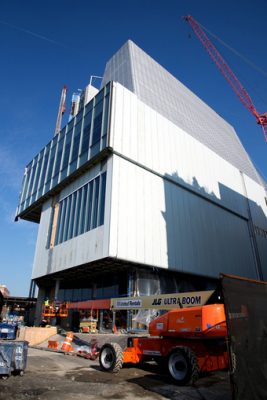
photograph by Timothy Schenck, 2014
Construction of the Whitney Museum of American Art building, viewed from the Hudson River – added 8 Nov 2013:
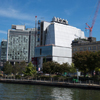
photograph by Timothy Schenck, Sep 2013
Renzo Piano architect
A view of the building looking west toward the Hudson River, June 2013:
Film on YouTube
Courtesy Whitney Museum of American Art
Construction of the Whitney Museum of American Art building, added Nov 7, 2013:
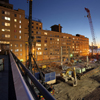
image courtesy Renzo Piano Building Workshop in collaboration with Cooper, Robertson & Partners
Section through the building, added 6 Nov 2013:
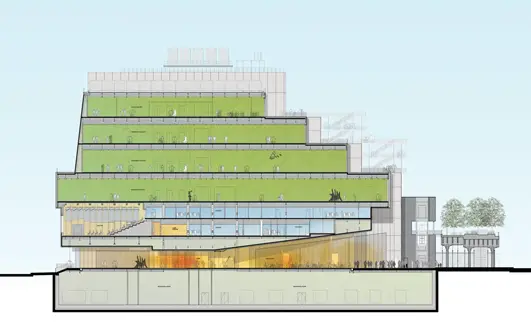
image courtesy Renzo Piano Building Workshop in collaboration with Cooper, Robertson & Partners
Proposed view from the High Line of the Whitney Museum of American Art building, added 7 Nov 2013:
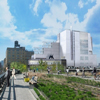
image courtesy Renzo Piano Building Workshop in collaboration with Cooper, Robertson & Partners
Construction of the Whitney Museum of American Art building, added 7 Nov 2013:
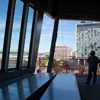
photograph by Timothy Schenck, by permission of the Whitney Museum of American Art
Met Breuer New York Building – Mar 28, 2016
New York City, USA
New York City Architecture
Contemporary New York Buildings
Manhattan Architecture Designs – chronological list
New York City Architecture Tours by e-architect
Whitney Museum, 945 Madison Avenue, Upper East Side
Date: 1966
Architect: Marcel Breuer
Whitney Museum Building New York
Whitney Downtown Museum Design
Architectural Provocateurs Axis Mundi Imagine a Different Whitney Downtown
Design: Axis Mundi, architects
Axis Mundi NYC
Whitney Museum Architect – Marcel Breuer
SoHo Tower in New York City
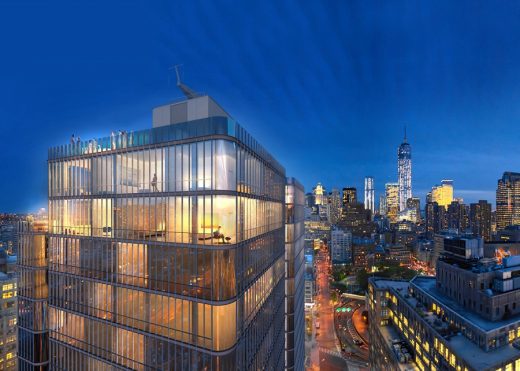
image courtesy Renzo Piano Building Workshop, architects
550 Broome Street Skyscraper New York City
New York City Architecture News
New York State Architecture Designs
Comments / photos for the Whitney Museum of American Art Building New York Architecture page welcome
Whitney Museum – Website: www.whitney.org

